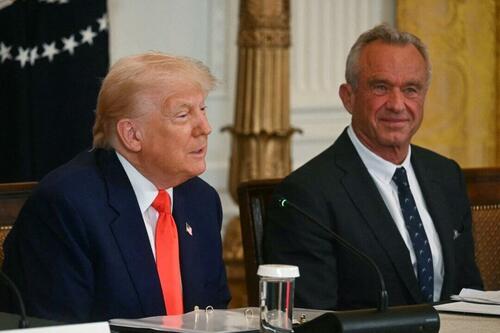Dollar, Bonds, and stocks sold amid a deluge of US data as Putin/Trump meeting awaits – Newsquawk US Market Wrap

- SNAPSHOT: Equities down, Treasuries down, Crude down, Dollar down.
- REAR VIEW: US retail sales in line, with control topping expectations; Industrial production unexpectedly declines; UoM sentiment surprisingly worsens while inflation expectations rise; Hotter-than-expected US import prices; NY Fed mfg. surpasses top end of forecasts; Trump floats 200/300% semiconductor tariffs; Trump/Putin now to be a three-on-three meeting; Japanese GDP (Q2) tops expectations; Poor AMAT guidance; Berkshire takes a new stake in UNH.
- WEEK AHEAD: Highlights include Jackson Hole, FOMC minutes; Japan & Canada CPI; PBoC, RBNZ, Riksbank. To download the report, please click here.
- CENTRAL BANK WEEKLY: Previewing PBOC, RBNZ, FOMC minutes, Riksbank, Jackson Hole; Reviewing RBA. To download the report, please click here.
More Newsquawk in 2 steps:
- 1. Subscribe to the free premarket movers reports
- 2. Trial Newsquawk’s premium real-time audio news squawk box for 7 days
MARKET WRAP
Stocks traded mostly in the red as tentativeness was present across markets ahead of the Trump/Putin meeting. Despite US Retail Sales matching expectations in July alongside a stronger-than-expected control figure (a better gauge of core spending), stocks came under pressure ahead of and after the cash open. Sector gains were led in Healthcare due to Berkshire Hathaway’s Q2 13F unveiling a new stake in UnitedHealth (UNH, +12%). As such, Dow outperformed SPX (-0.3%), NDX (-0.5%), and RUT (-0.6%). On the flip side, Financials were hit the most alongside Tech, with the latter weighed by fresh Trump remarks on tariffs on chip imports, “I’m going to have a rate that is going to be 200%, 300%”. Also weighing on semiconductors was poor guidance offered by Applied Materials in their Q3 report (AMAT, -14%). Back to the data, industrial production unexpectedly declined, import prices were hot (note: the BEA excludes tariffs from import and export price index calculations), UoM Sentiment unexpectedly worsened, and NY Fed mfg surged above expectations. Thereafter, the Atlanta Fed GDPnow model continues to track Q3 GDP growth at 2.5%. The US data led Treasuries to continue their descent lower with the curve bear steepening into the weekend. Meanwhile, the dollar pared most of the PPI-induced strength seen on Thursday, with JPY weighing on the Dollar Index after a GDP (Q2) beat. Crude prices settled lower, ending the week in the red ahead of the Trump-Putin meeting in Alaska. Bloomberg reports that the US has readied a suite of options to punish Russia if talks fail; the US mulls Rosneft and Lukoil sanctions if Putin baulks on a ceasefire.
US
RETAIL SALES: Retail sales for July rose 0.5%, as forecasted, easing from the upwardly revised 0.9% in June. Ex-autos fell to 0.3%, in line with consensus, from 0.8% (initially 0.5%), and ex-gas/autos dropped to 0.2% from 0.8% (initially 0.6%). The closely watched retail control printed 0.5% from 0.8% (initially 0.5%), but above the forecasted 0.4%, which Pantheon Macroeconomics quips still looks reasonably healthy even in volume terms, given that the relevant components of the CPI rose by only around 0.1%. Pantheon adds the report will ease some of the worries about the health of consumers’ spending following the tariff shock, given the modest further gains in underlying sales volumes and the upward revisions to the earlier months’ numbers. Despite saying that, Pantheon notes growth in consumption still looks relatively weak, and the softening labour market and further likely pass-through of tariffs suggest a sharp reacceleration is unlikely. On the headline figure, just over half of the rise was due to a further 1.6% recovery in auto sales. PM adds that auto sales have held up relatively well recently, partly because the pass-through of tariffs to vehicle prices has so far been very limited, but that seems unlikely to last indefinitely.
IMPORT/EXPORT PRCIES: Import Prices rose 0.4% in July, above the 0.0% expected, with the prior 0.1% revised down to -0.1%. Import Fuel prices jumped 2.7% (prev. 0.8%), the largest increase since January 2025, driven by higher prices for import petroleum and import natgas. Meanwhile, prices for non-fuel imports advanced 0.3% (prev. -0.3%) as higher prices for nonfuel industrial supplies and materials, consumer goods, and capital goods more than offset lower prices for automotive vehicles and foods, feeds, and beverages. Export Prices increased 0.1% as expected (prev. 0.5%). Agricultural export prices were unchanged (prev. 0.8) due to higher prices for meat and vegetables being offset by lower prices for corn and animal feeds. Exports-ex agriculture rose 0.1% (prev. 0.5%), due to higher prices for automotive vehicles and capital. Following the data, Citi’s July Core PCE now tracks at 0.27% M/M, and it was initially at 0.29% M/M after CPI and PPI data this week.
NY FED MANUFACTURING: NY Fed Manufacturing jumped to 11.9 in August from 5.5, above the expected 0.0. New orders and shipments rose to 15.4 (prev. 2.0) and 12.2 (prev. 11.5), respectively, while inventories tumbled to -6.4 from 15.6. On the inflationary footing, both prices paid and received fell to 54.1 (prev. 56.0) and 22.9 (prev. 25.7), respectively. The forward-looking indicators six months ahead saw general business conditions fall to 16.0 from 24.1, while prices paid expectations rose, but received fell. Richard Deltz, Economic Research Advisor at the NY Fed, said “Manufacturing activity grew modestly in New York State in August, with the survey’s headline index rising to its highest level since November 2024. New orders and shipments increased. While firms expect business conditions to improve, optimism edged down compared to last month”.
INDUSTRIAL PRODUCTION: Industrial production fell 0.1% in July from the 0.4% rise in May, against an expected 0.0%. Manufacturing output was unchanged (prev. 0.3%), better than the forecasted 0.1% decline. Capacity utilization ticked lower to 77.5% from 77.7%, as per Wall St. consensus. Overall, Oxford Economics notes it is a soft start to an even weaker H2 for IP, and was due to further weakness amid uncertainty, the price shock tied to equipment orders, and a real income strain on consumers. However, OxEco states that taking a step back, they look for a rebound in IP next year due to a fiscal boost, interest-rate relief, and investment in the high-tech sectors.
MICHIGAN: Prelim University of Michigan for August saw sentiment fall to 58.6 (exp. 62.0, prev. 61.7), Conditions tumble to 60.9 (exp. 67.9, prev. 68.0), outside the bottom end of the forecast range, and Expectations fall to 57.2 from 57.7, but above the expected 56.5. In terms of inflation expectations, 1yr and 5yr ahead rose to 4.9% (prev. 4.5%) and 3.9% (prev. 3.4%), respectively. Joanne Hsu, Surveys of Consumers Director, said, “Consumer sentiment fell back about 5%, declining for the first time in four months and largely stems from rising worries about inflation. Buying conditions for durables plunged 14%, its lowest reading in a year, on the basis of high prices.” Hsu added, “Overall, consumers are no longer bracing for the worst-case scenario for the economy feared in April when reciprocal tariffs were announced and then paused. However, consumers continue to expect both inflation and unemployment to deteriorate in the future”.
GOOLSBEE (2025 voter) speaking on the inflation reports, said the latest PPI and CPI data have a note of unease, and still need another inflation report to figure out if still on the “golden path”. Chicago Fed President added “let’s not overreact to one month of PPI, CPI, import prices, but it’s an area of concern.” On inflation, Goolsbee said he is feeling uneasy about services inflation data; hoping it’s a blip, if it’s persistent, then it will be cause for concern. Regarding rates, noted if the Fed gets a hint for September or later in the fall that the US is not in an inflationary spiral, then the Fed can cut rates.
FIXED INCOME
T-NOTE FUTURES (U5) SETTLED 6+ TICKS LOWER AT 111-19
T-Notes steepen as US data leans hot. At settlement, 2-year +2.0bps at 3.759%, 3-year +1.9bps at 3.722%, 5-year +2.4bps at 3.845%, 7-year +3.0bps at 4.061%, 10-year +3.3bps at 4.326%, 20-year +4.4bps at 4.902%, 30-year +4.2bps at 4.925%.
INFLATION BREAKEVENS: 1-year BEI -3.0bps at 3.219%, 3-year BEI -1.6bps at 2.700%, 5-year BEI -2.0bps at 2.443%, 10-year BEI -1.2bps at 2.370%, 30-year BEI -0.6bps at 2.271%.
THE DAY: Treasuries similar to Bunds and Gilts trended lower throughout the day, starting in the early European morning. Choppy trade arose from the US Retail Sales, import/export prices, and the NY Fed Manufacturing. Ultimately, the direction of trade resumed to the downside, given all reports flashed signals of a hotter US economy than expected. Retail Sales showcased a more resilient consumer both on the headline and control gauges, with welcome upward revisions. Import prices rose above expectations, albeit it was largely a function of a surge in fuel import prices. Meanwhile, the NY Fed Manufacturing, which offers an early glimpse into US data for the month of August, saw the headline surge above expectations and the consensus range on account of an increase in new orders and shipments. UoM Sentiment surprised on the downside, weighed by a steeper drop in economic conditions, while Industrial Production unexpectedly declined 0.1% (exp. 0.0%). Following this week’s data, the updated Atlanta Fed GDPnow (Q3) remains at 2.5%. From the open of 111-26+, Treasuries now sit around just above the lows of 111-17+. At the Fed, Goolsbee notes this week’s CPI and PPI reports had a note of unease, and he is feeling uneasy about services inflation
STIRS/OPERATIONS
- Market Implied Fed Rate Cut Pricing: September 22bps (prev. 23bps), Oct 36bps (prev. 38bps), Dec 55bps (prev. 57bps).
- NY Fed RRP op demand at USD 34bln (prev. 29bln) across 16 counterparties (prev. 14).
- EFFR at 4.33% (prev. 4.33%), volumes at USD 114bln (prev. 116bln) on August 13th.
- SOFR at 4.34% (prev. 4.33%), volumes at USD 2.767tln (prev. 2.796tln) on August 13th.
CRUDE
WTI (U5) SETTLED USD 1.16 LOWER AT 62.80/BBL; BRENT (V5) SETTLED USD 0.99 LOWER AT 65.85/BBL
The crude complex saw weakness to end the week, despite the Dollar’s strength, as all participants await the pivotal Trump/Putin meeting. Heading into it, the White House and the US President have consistently played down expectations, describing it as a listening exercise and Trump calling it a “feel‑out meeting”. All in all, it is difficult to envision a smooth solution to the Russia-Ukraine war through this summit, with Moscow demanding Ukraine give up some territory, something which is an absolute no-go for Kyiv. Today, Trump said if the meeting doesn’t go well, ‘I would walk’. Overall, energy-specific newsflow was light to end the week as this major macro risk event awaits, which has the ability to shake markets. For the record, the weekly Baker Hughes rig count saw oil rise 1 to 412, natgas fall 1 to 122, leaving the total unchanged at 539.
EQUITIES
CLOSES: SPX -0.26% at 6,451, NDX -0.51% at 23,712, DJI +0.08% at 44,946, RUT -0.56% at 2,286.
SECTORS: Financials -1.12%, Technology -0.75%, Industrials -0.55%, Utilities -0.37%, Consumer Discretionary -0.27%, Energy -0.25%, Materials -0.02%, Consumer Staples +0.07%, Communication Services +0.49%, Real Estate +0.68%, Health +1.65%.
EUROPEAN CLOSES: Euro Stoxx 50 +0.24% at 5,448, Dax 40 -0.01% at 24,375, FTSE 100 -0.42% at 9,139, CAC 40 +0.67% at 7,923, IBEX 35 +0.50% at 15,282, PSI +0.75% at 7,780, SMI +0.58% at 12,066, AEX -0.29% at 896
STOCK SPECIFICS:
- Applied Materials (AMAT): Poor guidance & cited weaker demand amid US-China trade tensions.
- SanDisk (SNDK): Q1 profit guidance underwhelmed.
- Nu Holdings (NU): Revenue beat.
- Intel (INTC): Extended on gains in late trade on Thurs. amid reports, the US is discussing taking a stake in Co.
- Hims & Hers Health (HIMS): FTC investigating the Co.
- Target (TGT): Downgraded at BofA to ‘Underperform’ from ‘Neutral’.
- PAR Tech (PAR): Upgraded to ‘Buy’ from ‘Neutral’ at BTIG.
- Wingstop (WING): Upgraded to ‘Strong Buy’ from ‘Outperform’ at Raymond James.
FX
The Dollar was weaker on Friday and gave back some of its PPI-induced strength. Despite a slew of US data, the Dollar was largely unmoved ahead of the well-documented Putin/Trump summit this evening, and then followed by Fed Chair Powell at Jackson Hole next week. Recapping the data, import prices M/M for July came in hotter-than-expected, but as Fed’s Goolsbee stated, import/export price data does not include tariffs, and tariffs are likely on top of these prices. In the wake of import/export, Citi’s July Core PCE now tracks at 0.27% M/M, which was initially at 0.29% M/M after CPI and PPI data this week. Elsewhere, retail sales were largely in line, NY Fed mfg. Impressed, IP slightly missed, and UoM was mixed, but inflation expectations rose.
G10 FX was exclusively firmer, and profited off the weaker Greenback, as opposed to much currency-specific newsflow, as the next inflexion point for markets is the aforementioned Trump/Putin meeting. The Yen, alongside the EUR, was the G10 outperformer. EUR/USD traded between 1.1647-1.715, with desks noting how EUR/USD, EUR/CHF and EUR/JPY trade on Monday morning will be a good gauge of how markets have digested any headlines from Alaska. Next week’s highlight out of the bloc is PMI metrics. For the Yen, Japanese Q2 GDP was better than expected overnight and gave the JPY a slight boost, albeit marginally, as USD/JPY hit a low of 146.75 on Friday, against an earlier peak of 147.86.
To avoid repeating myself, GBP drivers were sparse, but next week participants will be cognizant of more inflation data, flash PMIs and retail sales. In the wake of the August BoE rate cut, which saw a higher-than-expected level of dissent on the MPC due to inflationary development, the CPI release will take centre stage. As it stands, markets price just a 28% chance of a cut in November, with the next reduction not fully priced until March next year.
Antipodeans saw slight gains and managed to overcome the disappointing Chinese activity data overnight, which showed retail sales fell short of the bottom end of Wall St. consensus.
Loading…














